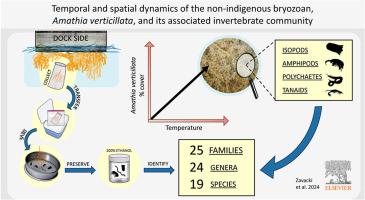非土著贝类蚯蚓(Amathia verticillata)及其相关无脊椎动物群落的时空动态
IF 2.6
3区 地球科学
Q1 MARINE & FRESHWATER BIOLOGY
引用次数: 0
摘要
广泛分布的非本土贝类 Amathia verticillata 主要在沿海海湾和港湾的人为结构上定植。尽管人们普遍认为这种形成生境的浮游动物会在其结构中容纳各种海洋无脊椎动物,但对其在美国南加州的时空动态及其相关无脊椎动物群落却知之甚少。因此,我们在一个城市化的河口(圣地亚哥使命湾)开展了一项为期一年(2021 年 7 月至 2022 年 7 月)的综合研究,在环境条件不同的 6 个站点量化蚯蚓的覆盖率和非生物条件。任务湾内温度和盐度的季节和空间梯度符合预期,季节性高盐度是地中海气候区的典型特征。A. verticillata 的覆盖率与温度呈正相关,在最温暖的时期发现最高的覆盖率,在较温暖的使命湾东部地区发现较高的平均覆盖率。我们还收集了三个重复的疣螈群落,以确定与这种非本地贝类相关的海洋无脊椎动物群落的特征。我们确定了属于两足类、等足类、蕉叶类和多毛类的 25 科、24 属和 19 种生物。此外,我们还发现了生活在A. verticillata中的幼体和卵生雌体。所发现的无脊椎动物科对群落的贡献率均未超过 21%。大戟属无脊椎动物的季节性生长和年度时间模式可能会阻止竞争优势物种在无脊椎动物群落中立足,并使大戟属无脊椎动物群落具有多样性。等脚类动物是浮游动物群落中最常见的种类,这可能反映了它们对环境的广泛耐受性。此外,虽然在蚯蚓体内发现的一些无脊椎动物也是非本地物种,但还需要做更多的工作来确定蚯蚓是否过多地支持这些物种而不是本地物种。总之,我们的研究结果表明,疣柄菊在人为建筑物上可作为甲壳类和多毛目动物的育幼栖息地。此外,A. verticillata在其分布范围内形成了类似的群落,这可能表明入侵正在使全球生物群同质化。本文章由计算机程序翻译,如有差异,请以英文原文为准。

Temporal and spatial dynamics of the non-indigenous bryozoan, Amathia verticillata, and its associated invertebrate community
The widespread non-indigenous bryozoan, Amathia verticillata primarily colonizes in coastal bays and harbors on anthropogenic structures. Although this habitat-forming bryozoan is widely recognized to house a variety of marine invertebrates within its structure, little is known about their spatiotemporal dynamics and their associated invertebrate community in Southern California, USA. Thus, we undertook a comprehensive yearlong study (July 2021–2022) in an urbanized estuary (Mission Bay, San Diego) to quantify A. verticillata percent cover and abiotic conditions at 6 stations with varying environmental conditions. The seasonal and spatial gradients in temperature and salinity within Mission Bay were as expected with seasonal hypersalinity typical of Mediterranean climate regions. The percent cover of A. verticillata was positively correlated with temperature with the highest percent cover found during the warmest periods, and higher average percent cover found in the warmer, eastern parts of Mission Bay. We also collected three replicate A. verticillata colonies to characterize the marine invertebrate community associated with this non-indigenous bryozoan. We identified 25 families, 24 genera, and 19 organisms to species belonging to the taxonomic groups: amphipods, isopods, tanaids, and polychaetes. Furthermore, we identified juvenile stages and ovigerous females living within A. verticillata. None of the identified invertebrate families contributed more than 21 % to the community. The seasonal growth and annual temporal patterns of A. verticillata may prevent competitively dominant species from becoming established within the invertebrate community and allow A. verticillata to harbor a diverse invertebrate community. Sphaeromatidae isopods were the most common family found in the bryozoan colonies, likely reflecting their broad environmental tolerances. Additionally, while some of the invertebrates found within A. verticillata were also non-indigenous species, more work needs to be done to determine if A. verticillata disproportionately supports these species over native species. Collectively, our results imply that A. verticillata functions as a nursery habitat on anthropogenic structures for peracarid crustaceans and polychaetes. Furthermore, A. verticillata assemble analogous communities across their distribution, which may indicate that invasions are homogenizing biota globally.
求助全文
通过发布文献求助,成功后即可免费获取论文全文。
去求助
来源期刊
CiteScore
5.60
自引率
7.10%
发文量
374
审稿时长
9 months
期刊介绍:
Estuarine, Coastal and Shelf Science is an international multidisciplinary journal devoted to the analysis of saline water phenomena ranging from the outer edge of the continental shelf to the upper limits of the tidal zone. The journal provides a unique forum, unifying the multidisciplinary approaches to the study of the oceanography of estuaries, coastal zones, and continental shelf seas. It features original research papers, review papers and short communications treating such disciplines as zoology, botany, geology, sedimentology, physical oceanography.

 求助内容:
求助内容: 应助结果提醒方式:
应助结果提醒方式:


